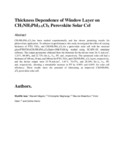Thickness Dependence of Window Layer on CH3NH3PbI3-XClX Perovskite Solar Cel
| dc.contributor.author | Isoe, Wycliffe | |
| dc.contributor.author | Mageto, Maxwell | |
| dc.contributor.author | Maghanga, Christopher | |
| dc.contributor.author | Mwamburi, Maurice | |
| dc.contributor.author | Odari, Victor | |
| dc.contributor.author | Awino, Celline | |
| dc.date.accessioned | 2021-07-07T13:22:14Z | |
| dc.date.available | 2021-07-07T13:22:14Z | |
| dc.date.issued | 2020-07-28 | |
| dc.identifier.uri | https://doi.org/10.1155/2020/8877744 | |
| dc.identifier.uri | https://www.hindawi.com/journals/ijp/2020/8877744/ | |
| dc.identifier.uri | http://r-library.mmust.ac.ke/123456789/1753 | |
| dc.description.abstract | CH3NH3PbI3-xClx has been studied experimentally and has shown promising results for photovoltaic application. To enhance its performance, this study investigated the effect of varying thickness of FTO, TiO2, and CH3NH3PbI3-xClx for a perovskite solar cell with the structure glass/FTO/TiO2/CH3NH3PbI3-xClx/Spiro-OMeTAD/Ag studied using SCAPS-1D simulator software. The output parameters obtained from the literature for the device were 26.11 mA/cm2, 1.25 V, 69.89%, and 22.72% for Jsc, Voc, FF, and , respectively. The optimized solar cell had a thickness of 100 nm, 50 nm, and 300 nm for FTO, TiO2, and CH3NH3PbI3-xClx layers, respectively, and the device output were 25.79 mA/cm2, 1.45 V, 78.87%, and 29.56% for Jsc, Voc, FF, and , respectively, showing a remarkable increase in FF by 8.98% and 6.84% for solar cell efficiency. These results show the potential of fabricating an improved CH3NH3PbI3-xClx perovskite solar cell. | en_US |
| dc.language.iso | en | en_US |
| dc.publisher | International Journal of Photoenergy | en_US |
| dc.subject | Thickness, Dependence, Window, Layer ,CH3NH3PbI3-XClX ,Perovskite, Solar, Cel | en_US |
| dc.title | Thickness Dependence of Window Layer on CH3NH3PbI3-XClX Perovskite Solar Cel | en_US |
| dc.type | Article | en_US |
Files in this item
This item appears in the following Collection(s)
-
Gold Collection [996]

